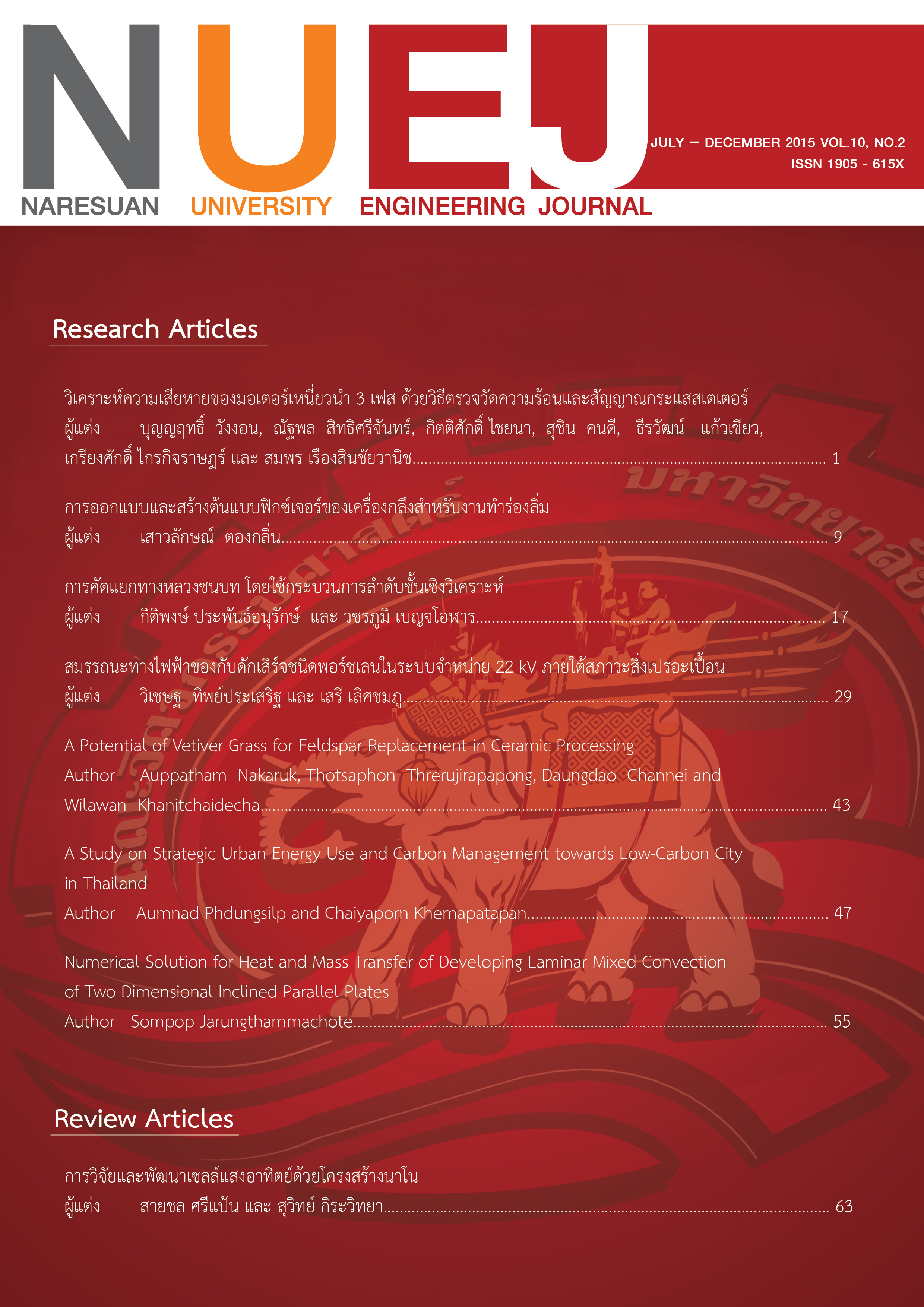A Potential of Vetiver Grass for Feldspar Replacement in Ceramic Processing
Main Article Content
Abstract
Vetiver grass is one of the most common grass in Thailand. It has been grown in many locations for land erosion prevention, toxic pollutants removal, and environmental remediation. The chemical analysis revealed that vetiver grass consisted of >50 % of K and ~20% of Si. This data suggested that the vetiver grass is possible to replace feldspar in ceramic processing. The thermal analysis of vetiver grass also confirmed that the vetiver grass can act as fluxing agents to form a glassy phase at low temperatures (873 K). The effect of vetiver grass on feldspar replacement on some properties of ceramics were investigated such as density, porosity, and bending stress. The results showed that with increasing the ratio of vetiver grass the density of sample decreased from 2.20 g/cm3 (100% of feldspar) to 1.91 g/cm3 (100% vetiver grass). The explanation is that during the firing process vetiver grass can generate CO2 from hydrocarbon decomposition, this CO2 created pores inside the sample, then the density was decreased. On the other hands, the bending stress decreased from 12.85 MPa (100% feldspar) to 9.07 MPa (100% vetiver grass). In conclusion, the results proved that the vetiver grass is a good candidate to replace feldspar in ceramic processing. This means it can be one option for promoting environmental sustainability in term of waste and mining reductions.
Article Details
References
S.O. Oshunsanya. “Spacing effects of vetiver grass (Vetiveria nigritana Stapf) hedgerows on soil accumulation and yields of maize–cassava intercropping system in Southwest Nigeria”, Catena, vol. 104, pp. 120–126, 2013.
N.O.Z. Abaga, S. Dousset, S. Mbengue, and C. Munier-Lamy. “Is vetiver grass of interest for the remediation of Cu and Cd to protect marketing gardens in Burkina Faso”, Chemosphere, vol. 113, pp. 42–47, 2014.
K.C. Makris, K.M. Shakya, R. Datta, D. Sarkar, and D. Pachanoor. “High uptake of 2, 4, 6-trinitrotoluene by vetiver grass – Potential for phytoremediation?”, Environ. Pollut., vol. 146, pp. 1–4, 2007.
M. Ye, M. Sun, Z. Liu, N. Ni, Y. Chen, C. Gu, F.O. Kengara, H. Li, and X. Jiang. “Evaluation of enhanced soil washing process and phytoremediation with maize oil, carboxymethyl-b-cyclodextrin, and vetiver grass for the recovery of organochlorine pesticides and heavy metals from a pesticide factory site”, J. Environ. Manage., vol. 141, vol. 161–168, 2014.
S.T.T. Le, N. Yuangpho, T. Threrujirapapong, W. Khanitchaidecha, and A. Nakaruk. “Synthesis of mesoporous materials from vetiver grass for wastewater treatment”, J. Aust. Ceram. Soc., vol. 51, vol. 40–44. 2015,
P. Methacanon, O. Chaikumpollert, P. Thavorniti, and K. Suchiva. “Hemicellulosic polymer from Vetiver grass and its physicochemical properties”, Carbohydr. Polym., vol. 54, pp. 335–342, 2003.
S.Kr. Das and K. Dana. “Differences in densification behaviour of K- and Na-feldspar-containing porcelain bodies”, Thermochim. Acta, vol. 406, pp. 199–206, 2003.
L. Vaculíková and E. Plevová. “Identification of clay minerals and micas in sedimentary rocks”, Acta Geodyn. Geomater., vol. 138, pp. 167–175, 2005.

